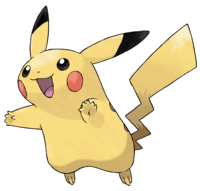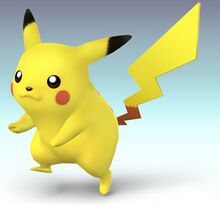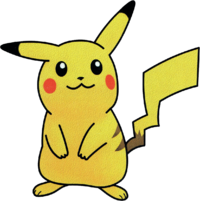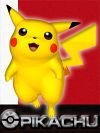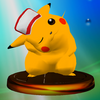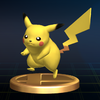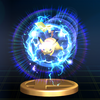Welcome to the Mario Compendium! If you want to request an account, please do so at Mario Wiki or Fanonpedia.
Pikachu
It has been requested that this article be rewritten and expanded to include more information. Reason: Later crossover appearances.
| Pikachu | |
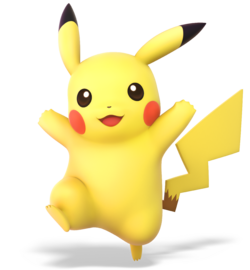 Pikachu, as depicted for Super Smash Bros. Brawl | |
| First appearance | Pocket Monsters Red Version and Pocket Monsters Green Version (1996, overall) Pokémon Red Version and Pokémon Blue Version (1998, outside Japan) Super Smash Bros. (1999, Mario-related media) |
| Species | Mouse |
| Latest portrayal | Ikue Ōtani |
Pikachu is the mascot of the popular Pokémon franchise by Game Freak. Pikachu is a a small yellow mouse, with pointy, black-tipped ears, red circles on its cheeks, and a tail in the shape of a lightning bolt. Pikachu's only major appearances alongside Mario is in the Super Smash Bros. series, although Pikachu has made a cameo in two games of the Mario franchise: Mario Artist: Paint Studio and Super Mario Maker.
Pikachu is portrayed by Ikue Ōtani in every Super Smash Bros. game, and she also voices Ash's Pikachu in Pokémon the Series.
Origin
The extensive variety of Pokédex entries available for Pikachu throughout the RPG series provides plenty of biological information: It lives in forests in groups away from people, and it keeps its tail raised as it monitors its surroundings. The tail is sometimes struck by lightning in this pose, and it will try to bite whatever yanks its tail. Its red cheeks are electricity-storing pouches which appear to become electrically charged overnight while Pikachu sleeps. It occasionally discharges electricity when it is dozy after waking up. Shooting out stored-up electricity from its cheeks is its primary offensive measure; if threatened, angered, or attacked, it discharges the electricity from its cheeks at the offender. When it releases pent-up energy in a full-on burst, the electric power unleashed is equal to a bona-fide lightning bolt. When several Pikachu gather together, the collective electricity among them may build and cause a lightning storm. It occasionally uses an electric shock to recharge a fellow Pikachu that is in a weakened state. An intelligent species, it jolts any new thing it comes across as a way of inspecting it. Whenever it comes across a hard berry, it uses its electricity to roast the berry to make it tender enough to eat, and it jolts any new thing it comes across. If you come across a blackened berry, it's evidence that a Pikachu mistook the intensity of its charge.
In the main series of video games, Pikachu is a relatively weak Electric-type Pokémon that can be found early in the original game. Unlike certain special monsters that had plot elements wrapped around them such as Mewtwo, Pikachu was just another Pokémon that could be caught, evolved into its higher form, Raichu, and had no bearing on the story. However, Pikachu's popularity in the anime, where it was the first and primary Pokémon of the main character, Ash Ketchum, eventually led to its starring its own specialized game titled Pokémon Yellow Version: Special Pikachu Edition, as the first Pokémon that the player obtained. Pikachu's role in the game was intensely elaborated on, as several events on the game depended on how Pikachu felt towards the player. Depending on the player's actions towards Pikachu, the electric rat Pokémon would exhibit a variety of emotions when spoken to, varying from frustration, to amusement, to complete adoration. Pikachu's happiness was sometimes a prerequisite for certain rewards in the game, such as attaining the three Pokémon that could be chosen as starters from Pokémon Red Version and Pokémon Blue Version.
Pikachu has not had a starring role in any of the main games in the series since then, but it has been featured in every prominent handheld RPG since the franchise, usually bringing something new with it each time. In Pokémon Gold Version and Pokémon Silver Version, released for the Game Boy Color in 2000, Pikachu gained a new evolutionary phase in the form of Pichu. It also gained an item called the Light Ball, which doubled Pikachu's Special Attack when held. However the item was only obtainable when trading a Pikachu over from Pokémon Yellow Version: Special Pikachu Edition. Pokémon Ruby Version and Pokémon Sapphire Version have an upper version titled Pokémon Emerald Version, which games Pikachu an Egg Move exclusive to it and its family, called Volt Tackle, which was an exceptionally powerful Electric-attack with a large recoil. Pokémon Diamond Version and Pokémon Pearl Version introduced cosmetic differences between genders for certain species of Pokémon, and Pikachu was one of them, with the females having a dent at the end of their tail. The Light Ball also gained a new feature in this game - allowing both Pikachu's normal and Special Attacks to be doubled.
Pikachu has also been in virtually every Pokémon related spinoff game ever released, sometimes as the star or a main character, and other times just featured among the hundreds of other Pokémon in the series. Notable Pikachu-centric games include Hey You, Pikachu! for the Nintendo 64, where the player could talk to Pikachu using the microphone, Pokémon Channel, which is usually regarded as a spiritual sequel to the previous title, and the Pokémon Mystery Dungeon games, where Pikachu is one of 16 Pokémon that the player can start out as. Pikachu has also been made into a Tamagotchi-style virtual pet called the Pocket Pikachu, a little LCD device that owners could clip onto their belt. Whenever the user took a step, it would register on the system, which would give Pikachu points in the form of "watts".
Due to Pokémon's intense popularity, Pikachu was included in Super Smash Bros., along with another Pokémon made popular by the anime, Jigglypuff. Pikachu's Electric-type attacks and speed were added into the game and has returned in every other Super Smash Bros. title.
History
Super Smash Bros. series
| Super Smash Bros. character Pikachu |
| Game appearances |
|---|
Super Smash Bros. Melee Super Smash Bros. Brawl |
| Special moves |
| Standard: Thunder Jolt Side: Skull Bash Up: Quick Attack Down: Thunder |
| Battle entrance |
Super Smash Bros.
Pikachu appeared as a default character in Super Smash Bros. It was a useful player, as its electric attacks could inflict serious damage. However, its Quick Attack was its prize move, as it could escape almost every fall, if done correctly. However, it is rather light, and can be knocked off the stage easily.
Super Smash Bros. Melee
Pikachu returns in Super Smash Bros. Melee as a default player once more. It retains all of the same moves as before, and its added side special move is Skull Bash. The game introduces Pikachu's pre-evolved form Pichu as a fighter, and Pichu has a moveset similar to Pikachu's.
Super Smash Bros. Brawl
Pikachu was one of the first characters revealed for Super Smash Bros. Brawl. Its Final Smash is Volt Tackle, in which Pikachu becomes a giant electrical ball that moves around the stage randomly.
Adventure Mode: The Subspace Emissary
Pikachu starts off trapped within a strange device that harnesses its electrical energy to provide power to the complex. Samus, infiltrating the complex in search of her Power Suit, sees that the device causes Pikachu pain, and breaks it. In thanks, Pikachu helps Samus continue through the lab. Eventually, the pair come across Samus's Power Suit within a tank. After dispatching two clones of Samus, Pikachu helps Samus (in her newly regained Power Suit) through the rest of the facility and helps her defeat Ridley.
After escaping from the complex, Pikachu and Samus infiltrate the Subspace Bomb Factory and encounter the Ancient Minister. Despite Donkey Kong, Diddy Kong, Captain Falcon, and Captain Olimar coming in soon after, the Ancient Minister does not fight back, and tries to stop the other R.O.B.s from obeying Ganondorf. Ganondorf gets the R.O.B.s to set up multiple Subspace Bombs, and the Anceint Minister, with the R.O.B.s no longer under his control, reveals himself to be the head R.O.B. of the island and helps Pikachu and the others defeat the Subspace Army and escape the island in the Falcon Flyer before it is consumed by Subspace.
Pikachu and the rest of its team join the remaining heroes in their last stand against Subspace, only to be defeated by Tabuu. Fortunately, King Dedede had planned this in advance and created badges that revived fighters from being trophies. Using these, he is able to form a team conisting of himself, Luigi, and Ness. Dedede and his group then revived most of the others, including Pikachu, before everyone has rejoined and proceeded to face Tabuu in a final battle.
Profiles and statistics
Super Smash Bros.
Pikachu
Mouse PKMN
Height 1'04"
Weight 13lbs
When several of these Pokémon gather, their electricity could cause lightning storms.
(Pokédex excerpt)
Super Smash Bros. Melee trophies
Super Smash Bros. Brawl trophies
| # | Name | Image | Appearance(s) | Description |
|---|---|---|---|---|
| 15 | Pikachu | GB Pokémon Red/Blue DS Pokémon Diamond/Pearl |
A Mouse Pokémon. Its lightning-bolt tail and round cheeks are its trademarks. When danger draws near, it uses tiny electric pouches within its cheeks to discharge electricity. When it's really fired up, it unleashes thunderbolts on its rivals. It's said to recharge when it's sleeping. It evolves into Raichu. | |
| 16 | Volt Tackle | WII Super Smash Bros. Brawl | Pikachu, transformed into a ball of light that can slam into foes. It can also fly to chase down those who try to jump out of range. Sparks get stronger when you press the attack button. However, its increased inertia makes midair movement tough. If you get carried away flying, the effect will end, and you'll destroy yourself. Be careful it doesn't happen to you. |
Super Smash Bros. Brawl stickers
| Image | Game | Effect |
|---|---|---|
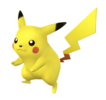
|
Pokémon series | [Electric] - Attack +33 Usable by: Pikachu |
Solid Snake codec conversation
- Mei Ling: (overjoyed) Ooh, how cuute!
- Snake: What? The yellow thing?
- Mei Ling: That's Pikachu. It's a Pokémon. They're popular all over the world, you know. And it may look cute, but be careful, It can store up large amounts of electricity in those adorable little cheeks. It'll try to pepper you with electric shocks.
- Snake: Couldn't be much worse than Ocelot's old torture device...
- Mei Ling: Oh, and, Snake?
- Snake: What?
- Mei Ling: I was wondering, could you maybe try and catch Pikachu for me? Pleeeeease?
- Snake: Give me a break! What do I look like, a Pokémon Trainer?
- Mei Ling: (disappointed) Fine... Sorry I asked.
Trivia
- One of its alternate outfits in Super Smash Bros. Brawl are a pair of goggles. These were worn by Pichu in Super Smash Bros. Melee.
- Pikachu is the only fighter to have only four recolors in Brawl. In fact, it has had only four recolors in all three installments of the Super Smash Bros. series.
Disclaimers

|
This page uses content from the Super Mario Wiki. The original page was at Pikachu. The list of authors can be seen in the page history. As with Mario Compendium, the text of the Super Mario Wiki from before June 9, 2010 is usable under the terms of the GNU Free Documentation License. |
| This page uses content from Smashpedia. The original article was at Pikachu. The list of authors can be seen in the page history. As with Mario Compendium, the text of Smashpedia from before June 19, 2009 is usable under the terms of the GNU Free Documentation License. |
